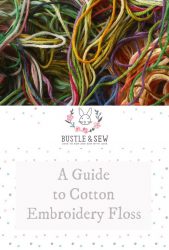You can use all kinds of threads for hand embroidery, offering almost limitless possibilities for variety of colour and texture, especially if your work is intended for display only. If it’s likely to be used and possibly washed then you will need to bear more practical considerations in mind!

The most common types of fibres used for surface embroidery today are cotton, silk and wool. The most common cotton thread used for hand embroidery today is 6-strand cotton floss. This comes in skeins, and the whole thread that comes off the skein can be split into six separate, fine threads. Each of these threads is made up of two smaller plies that are softly twisted together.
It’s really important to pull the “right” end of the skein when you’re using your floss – this will mean you can pull out the length you require really easily. Pulling from the “wrong” end will leave you with a nasty tangled mess! And of course the right end is always the hardest to find!
When embroidering with stranded cotton, you can choose to use any number of strands. When using one strand your embroidery will be quite fine. As you add strands, the resulting embroidery becomes heavier. If you stitch with all six strands, the stitches become chunky.
Pearl (or perle) cotton, unlike 6-strand cotton floss, cannot be divided. Pearl cotton is a twoply tightly twisted thread that gives quite a textured effect to your stitches. Because it is normally heavier than floss, line stitches like stem stitch and chain stitch usually sit higher up on the fabric, compared to the same stitches worked with floss.
Perle cotton comes in four sizes normally used in needlework: #3, #5, #8 and #12, with #3 being the heaviest and #12 being the finest.
In addition to floss and perle cotton, there are other cottons created specifically for hand embroidery, including floche and coton a broder, both of which are excellent hand embroidery threads. DMC and Anchor are the most widely available quality brands today. Never be tempted to buy cheap thread – you will be disappointed!
Want more hints & tips? Then click below to get our free newsletter – you’ll even get some fab free patterns too…
*article originally appeared in the October issue of Bustle & Sew Magazine. Find out more HERE!*

I am wondering, if tapestry and crewel yarn are the same?
Hi Susan – thanks for your question and no, they’re not. Tapestry yarn is generally thicker than crewel and can’t be split – or at least that is my understanding xx